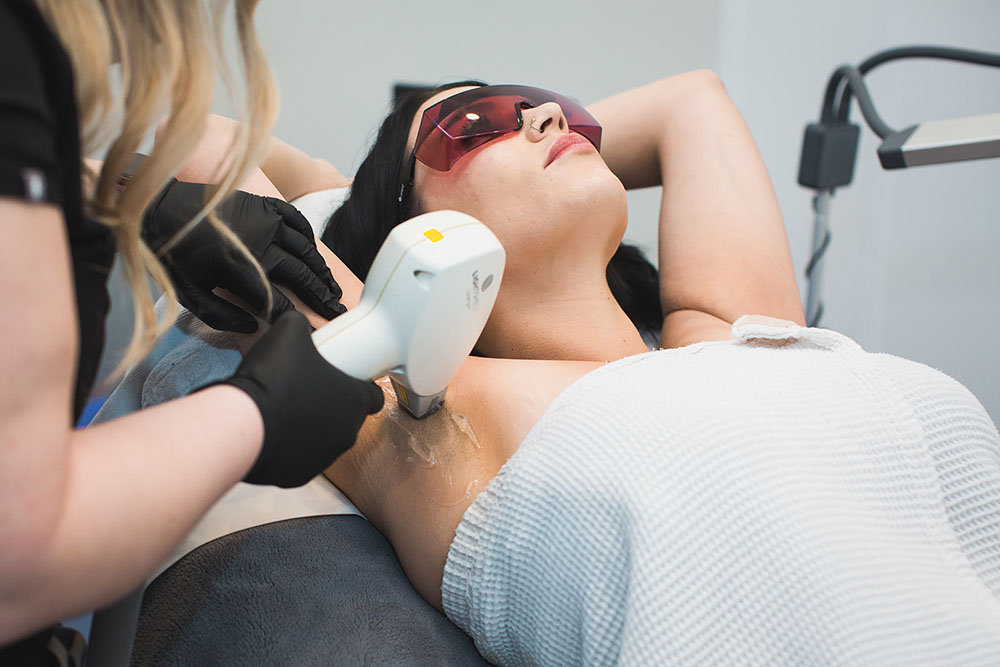Laser hair removal is a safe and clinically proven treatment. Hair growth significantly reduces after a few sessions, and issues like ingrown hairs and shaving rash disappear.
The standard bikini line laser treatment removes pubic hair one to two fingers wide in the area where your undergarment may brim over. It is the most popular treatment.

Unlike shaving and waxing which can leave bumps and redness in the bikini area laser hair removal can leave the skin looking smooth. It also prevents the build-up of ingrown hairs that can often occur in this area and stops the development of new hair follicles, stopping unwanted hair growth in the future.
Laser treatment can be used on all areas of the bikini line including the top, front, sides and labia. It can also be used on the entire perianal area and full buttocks if required.
It’s important to note that the hair follicles must be dark in colour for laser treatment to work. This is because the melanin pigment in the hair is what targets the heat from the laser to deactivate it and inhibit regrowth. Lighter coloured hair (blond, grey or red) does not respond to laser treatments as well so it’s necessary to have a consultation with one of our qualified laser technicians before starting a course.
It is also important to understand that the results from laser hair removal on the bikini line will not be permanent and regular top up sessions will be needed to maintain your reduced hair levels. However, a full course of treatment will remove most of the hair that was previously growing in this area for good and most people see an 80-85% reduction after a course of 8-10+ treatments.
How does laser hair removal work on the bikini line?
Bikini laser hair removal at Nadara Dermatology, Cosmetology and Laser Center is a safe and effective way to remove unwanted hair on the bikini area. This procedure will leave you with long-term results that eliminate the need for shaving, waxing and plucking.
In South Florida, many women struggle to maintain hard-to-groom Brazilian and bikini lines due to the thick, coarse nature of local hairs. Often, the hairs in this area are dark in color, which makes it difficult to achieve good results when shaving or waxing.
During a laser treatment, the hairs are targeted by pulses of light that penetrate the skin and disable the hair follicle. The number of sessions needed varies based on the individual’s skin type, the thickness of the hair and how many of the hair follicles are in a growing phase at any given time. Most people will need six to eight sessions to achieve long-term results.
The type of laser used also depends on the skin tone as different colors require a specific wavelength to disable the hair follicles. For pale/med skin tones, an alexandrite laser is used whereas darker skin tones are treated with an Nd:Yag laser that safely treats melanin in the hair and surrounding skin.
For those who want to avoid all of their pubic hairs being removed, a brazilian laser treatment can be done in addition to a bikini laser. A full Brazilian laser removes the hair on the sides of the pubic area and sometimes the top while a bikini front only removes the area that covers the labia.
How many sessions of laser hair removal are needed for a full course on the bikini line?
There is no set number of sessions required to achieve your desired results. However, it is important that you attend treatments every 6-7 weeks in order to target hairs that are in the anagen phase. Hairs that are in the catagen and telogen phases will not be targeted by laser.
Unlike shaving and waxing which leave skin bumpy, irritated and with shadow from the removed hair, laser treatment leaves the skin smooth and clear. In addition, the hair follicles are permanently disrupted which means that the growth of new hair is prevented.
Hair removal on the bikini area is a popular choice for women who are tired of using short-term methods such as shaving and waxing to get rid of unwanted hair. These methods cause painful regrowth and can lead to ingrown hairs which are unsightly, itchy and uncomfortable.
The hair on the labia and bum area tends to take longer to reduce compared with the top and sides but most people will see their results after a few sessions. As the course progresses hair growth will slow down and it is not uncommon for you to only need 2-3 top ups a year to maintain your reduction.
Laser hair removal on the bikini line is a permanent solution to hair removal and it also requires far less maintenance than other hair removal options like waxing or shaving. However, it is important to understand that the hair reduction from laser treatment is not permanent and regular top ups are required to maintain your reduced hair growth.
What results can I expect from laser hair removal on the bikini line?
Hair in this area can be difficult to remove through shaving, waxing and other methods of hair removal. It is usually thick and dark in colour making it even harder to maintain smooth skin. Ingrown hairs are also a common problem in this area and shaving can result in razor burn. Laser hair removal on the bikini line offers long-term results eliminating these problems and giving smooth skin.
A full bikini laser hair removal course will result in permanent hair reduction from the area. This means you will not need to shave or wax the area again and you will have longer hair-free periods in between treatments. A maintenance session is needed every two to four weeks after a complete course to hold the reduction.
Before your first appointment you should stop any plucking, waxing or electrolysis for six weeks prior to treatment. You should also avoid tanning and keep the area clean. A numbing gel will be applied to the area before your treatment starts. You will notice a bit of redness and itching after your appointment but this should disappear over the course of the week or two.
When deciding between a Brazilian or bikini laser hair removal it is best to think about what your objectives are for the treatment. If you are bothered by hairs around the panty line then a bikini laser hair removal should do the trick, whereas a Brazilian will address all areas of pubic hair including the labia and perianal area.
What areas of the bikini line are suitable for laser hair removal?
The entire area around your pubic region including the labia, perianal and upper thighs is suitable for laser hair removal. A course of laser treatment can drastically reduce hair growth, resulting in permanent hair reduction on your bikini line and other areas of the body.
Unlike shaving and waxing, laser treatments provide clear and smooth skin without any bumps or ingrown hairs. This is because the heat from the laser destroys the hair follicle, preventing future hair growth.
For optimal results, it’s recommended to use a sensitive shaving product in the weeks leading up to your first laser session. Also, avoid sunless tans and heavily scented products on the area as they may interfere with laser treatment.
Your laser technician will carefully choose a setting that is suitable for your skin tone and hair colour. Darker coloured hair absorbs the laser heat more easily than lighter hair, destroying the hair follicle and leaving you with smooth skin.
You can expect some redness or itching immediately after your laser session, though this should subside within a few hours. To help minimise post-treatment symptoms, apply Aloe Vera gel to the area regularly.
How do I prepare for laser hair removal on the bikini line?
It’s important to exfoliate the area that will be treated a few days before your laser hair removal session. This will remove any dead skin cells and make the procedure more effective. Just be sure to use a gentle exfoliation approach and avoid any rough scraping of the skin.
It is also a good idea to bathe on the day of your appointment. This will help to clean the bikini area and also open up your pores, making the treatment more effective. It’s also a good idea to bring some wet wipes with you so that you can use them to wipe the area down before your session.
You should also refrain from tanning or sunbathing in the weeks leading up to your appointment. This is because the laser cannot be used on sunburned or tanned skin. Tanning can also interfere with the effectiveness of the laser hair removal procedure, and it may require more sessions to get results.
Finally, it’s a good idea to avoid any scented lotions or perfumes on the day of your appointment. This is because they can cause irritation and sensitivity in the treatment area. If you do need to apply any cosmetics, be sure to use a light layer and only on the areas that are going to be treated. Also, it’s a good idea to wear loose-fitting clothing so that you don’t rub the treatment area as you move around.

